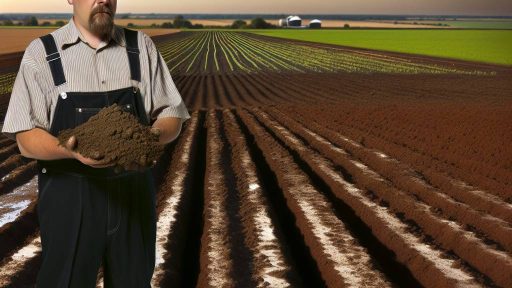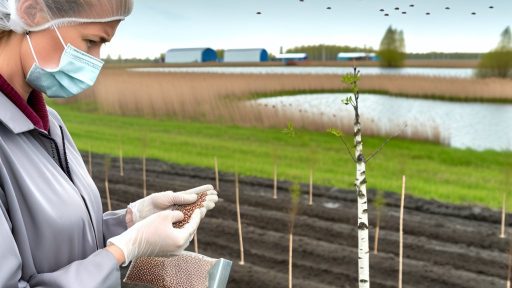Introduction to Climate Change and Its Impact on Agriculture
Climate change poses a significant threat to agriculture worldwide.
It alters weather patterns, leading to unpredictable rainfall and increased temperatures.
Farmers often struggle to adapt to these changing conditions.
Extreme weather events like droughts and floods have become more common.
This adversely affects crop yields and livestock health.
Understanding the Effects of Climate Change
The impacts of climate change are widespread and multifaceted.
For example, shifting growing seasons can disrupt traditional practices.
Additionally, pests and diseases may become more prevalent as temperatures rise.
Consequently, farmers must invest more in pest management and crop protection.
Furthermore, soil degradation can occur due to improper land management.
The Need for Resilience in Agriculture
To counter climate change effects, agriculture requires resilience.
Resilient systems can withstand and adapt to environmental shocks.
Farmers need strategies that enhance adaptive capacity.
For instance, diversifying crop production can minimize risks.
Moreover, agroforestry practices offer viable solutions to foster resilience.
Transform Your Agribusiness
Unlock your farm's potential with expert advice tailored to your needs. Get actionable steps that drive real results.
Get StartedAgroforestry as a Solution
Agroforestry integrates trees into agricultural landscapes.
This practice promotes biodiversity, improving ecosystem functionality.
Additionally, agroforestry can enhance soil health and water retention.
As a result, it can mitigate the adverse effects of climate change.
Farmers adopting agroforestry often see improved yields and sustainability.
What is Agroforestry?
Agroforestry integrates trees and shrubs into agricultural landscapes.
This approach enhances productivity and sustainability.
Farmers use agroforestry to improve soil health and fertility.
By incorporating trees, they increase biodiversity on their farms.
Additionally, agroforestry helps combat climate change.
Definition of Agroforestry
Agroforestry combines agriculture and forestry practices.
It involves growing crops alongside trees and shrubs.
This system creates a synergistic relationship between different species.
The trees offer shade and windbreaks for crops.
Furthermore, roots from trees prevent soil erosion.
Benefits of Agroforestry
Agroforestry provides numerous environmental benefits.
- Improved soil health through organic matter addition.
- Increased carbon sequestration to mitigate climate change.
- Enhanced biodiversity supporting various ecosystems.
- Water conservation through improved infiltration.
Moreover, agroforestry can increase farmers’ incomes.
Farmers can diversify their income sources by selling tree products.
Types of Agroforestry Systems
There are several types of agroforestry systems.
- Alley cropping: Crops grow between rows of trees.
- Silvopasture: Trees provide shade for livestock.
- Forest farming: High-value crops grow under forest canopies.
- Windbreaks: Trees protect crops from wind damage.
Each system has unique advantages suited to specific climates.
Additionally, they can be tailored to local ecological conditions.
Agroforestry in Practice
Many farmers globally adopt agroforestry practices.
For example, in Brazil, farmers use agroforestry to restore degraded lands.
In India, communities practice agroforestry to improve food security.
Showcase Your Farming Business
Publish your professional farming services profile on our blog for a one-time fee of $200 and reach a dedicated audience of farmers and agribusiness owners.
Publish Your ProfileThese real-world applications highlight agroforestry’s effectiveness.
Local governments often support these initiatives through funding.
The Role of Agroforestry in Enhancing Climate Resilience
Introduction to Agroforestry
Agroforestry integrates trees and shrubs into farming systems.
This approach improves biodiversity and enhances ecosystem services.
It provides multiple benefits, including improved soil quality and increased crop yields.
Building Resilience Against Climate Change
Agroforestry helps mitigate the impacts of climate change.
Trees enhance water retention in the soil, reducing drought stress.
Moreover, they create microclimates that can shield crops from extreme weather.
Improving Soil Health and Fertility
Rotating crops with trees enriches the soil year-round.
Root systems of trees stabilize the soil and prevent erosion.
Additionally, fallen leaves contribute organic matter to the soil.
Enhancing Biodiversity
Agroforestry promotes a diverse range of plant and animal species.
This diversity enhances ecological resilience and supports pollinators.
More varied ecosystems are better equipped to handle pests and diseases.
Economic Benefits of Agroforestry
Farmers can diversify their income through agroforestry practices.
They can harvest fruits, nuts, and timber along with conventional crops.
This results in more stable income streams under changing market conditions.
Case Studies of Successful Agroforestry Practices
Many successful examples demonstrate the viability of agroforestry.
In Brazil, farmers use agroforestry to restore degraded land.
This has led to increased yields and improved local ecosystems.
Similarly, in Kenya, agroforestry mitigates soil erosion in hilly areas.
Enhancing Climate Resilience Through Agroforestry
Adopting agroforestry enhances climate resilience significantly.
It offers multiple environmental, economic, and social benefits.
Agroforestry is a crucial strategy for sustainable land management.
Learn More: How Water Rights Policies Influence Agricultural Land Prices
Key Agroforestry Practices for Sustainable Property Development
Overview of Agroforestry
Agroforestry combines agriculture and forestry practices.
This approach creates diverse ecosystems on properties.
Additionally, agroforestry helps enhance resilience against climate change.
Integrating Trees into Crop Production
Integrating trees alongside crops offers multiple benefits.
Trees improve soil fertility and reduce erosion.
Moreover, they provide shade and protect crops from extreme weather.
Benefits of Trees in Crop Fields
Trees enhance biodiversity, attracting beneficial insects.
This biodiversity leads to better pest control and pollination.
Furthermore, trees can yield additional products like fruit and timber.
Silvopasture Systems
Silvopasture integrates trees, forage, and livestock on the same land.
This system optimizes land use while improving animal welfare.
Animals benefit from shade and improved forage quality.
Enhancing Soil and Water Conservation
Silvopasture promotes soil health by adding organic matter.
Additionally, it helps maintain water quality in surrounding areas.
This practice reduces runoff and minimizes soil erosion significantly.
Showcase Your Farming Business
Publish your professional farming services profile on our blog for a one-time fee of $200 and reach a dedicated audience of farmers and agribusiness owners.
Publish Your ProfileAlley Cropping
Alley cropping involves planting rows of trees with crops in between.
This method maximizes land productivity and resource use.
Crops receive sunlight while benefiting from tree-generated mulch.
Improving Microclimates
Trees act as windbreaks, reducing wind speed and protecting crops.
They contribute to more stable microclimates within farming areas.
Consequently, this results in better crop yields and resilience.
Cover Cropping with Agroforestry
Cover crops enhance soil health and prevent erosion.
Integrating these crops with tree systems boosts nutrient cycling.
As a result, farmers can reduce reliance on chemical fertilizers.
Enhancing Biodiversity
Cover crops provide habitats for various species.
They attract pollinators and beneficial organisms to the farm.
This leads to increased ecosystem health and productivity.
Community Engagement and Education
Successful agroforestry practices depend on community involvement.
Farmers should share knowledge and resources effectively.
Education on sustainable methods strengthens local resilience.
Workshops and Training Programs
Organizing workshops can enhance understanding of agroforestry techniques.
Additionally, training programs promote collaboration and innovation.
This builds a network of sustainable property developers.
Find Out More: Smart Greenhouse Technologies for Climate-Resilient Farm Investments
Integrating Trees with Crops: Benefits and Strategies
Enhancing Biodiversity
Integrating trees with crops enhances biodiversity on farms.
This approach provides habitats for various species.
Moreover, it helps to minimize pest populations naturally.
As a result, farmers can reduce their reliance on chemical pesticides.
Improving Soil Health
Trees contribute to the improvement of soil health.
Their roots help prevent soil erosion and compaction.
Additionally, tree litter enriches the soil with organic matter.
This practice enhances nutrient cycling for crops.
Water Management
Trees play a crucial role in managing water resources.
They improve water infiltration and reduce runoff.
This leads to better water retention in the soil.
Consequently, crops benefit from a more reliable water supply.
Shade and Microclimate Regulation
Integrating trees offers shade to crops during hot weather.
This helps to lower the temperature in the field.
As a result, crops experience less heat stress and retain moisture.
Furthermore, trees can create a more favorable microclimate.
Strategies for Integration
Farmers can adopt various strategies for tree-crop integration.
One effective method is alley cropping.
This involves planting rows of trees alongside crops.
Another strategy is silvopasture, where trees and livestock coexist.
Choosing the Right Species
Selecting appropriate tree species is vital for success.
Showcase Your Farming Business
Publish your professional farming services profile on our blog for a one-time fee of $200 and reach a dedicated audience of farmers and agribusiness owners.
Publish Your ProfileFarmers should consider local climate and soil conditions.
Native species often perform better and support local ecosystems.
Implementation Considerations
Farmers must plan for the long-term growth of trees.
They should assess the potential competition for resources.
Moreover, timing and spacing are crucial for optimal integration.
Collecting Data and Monitoring
Monitoring the performance of integrated systems is essential.
Farmers should collect data on crop yield and health.
This information can help fine-tune integration practices.
Continuous learning leads to improved outcomes over time.
Delve into the Subject: Managing Soil-Borne Diseases to Protect Agricultural Land Investments
Soil Health Improvement through Agroforestry Techniques
Enhancing Soil Structure
Agroforestry practices greatly improve soil structure.
They incorporate trees and shrubs with crops.
Roots from these plants bind the soil effectively.
This reduces erosion and enhances water retention.
Consequently, it creates a healthier growth environment.
Increasing Nutrient Availability
Agroforestry systems promote nutrient cycling.
Tree leaves decompose and enrich the soil.
This organic matter boosts nutrient availability.
In turn, crops benefit from improved soil fertility.
Farmers yield healthier and more productive plants.
Promoting Biological Diversity
Agroforestry enhances biodiversity in agricultural systems.
Diverse plant species attract various beneficial organisms.
These organisms improve soil health and pest control.
Furthermore, biological diversity sustains soil resilience.
This approach leads to more stable and productive ecosystems.
Facilitating Water Management
Incorporating trees aids in effective water management.
They reduce surface runoff and enhance infiltration.
Agroforestry systems help capture rainfall efficiently.
Thus, they support plants during dry seasons.
Trees significantly improve moisture retention.
Sequestering Carbon
Agroforestry techniques contribute to carbon sequestration.
Trees absorb carbon dioxide from the atmosphere.
This helps mitigate climate change impacts.
Healthier soils lead to more carbon storage.
Revitalized ecosystems can store more carbon long-term.
Find Out More: Agroforestry Strategies for Climate-Resilient Land Development

Case Studies: Successful Climate-Resilient Agroforestry Projects
Agroforestry in West Africa
In West Africa, agroforestry has transformed local communities.
Farmers integrate tree planting with crop production.
This improves soil fertility and reduces erosion.
For instance, the World Agroforestry Centre led an initiative.
Showcase Your Farming Business
Publish your professional farming services profile on our blog for a one-time fee of $200 and reach a dedicated audience of farmers and agribusiness owners.
Publish Your ProfileThis project resulted in increased crop yields and biodiversity.
Agroforestry Practices in Central America
Central America showcases successful agroforestry practices.
Farmers blend coffee production with shade trees.
This method enhances coffee quality while preserving forests.
The Rainforest Alliance supports these sustainable methods.
As a result, farmers benefit from both income and environmental health.
Agroforestry in India
In India, agroforestry plays a crucial role in rural development.
Farmers plant trees alongside major crops such as rice and wheat.
This practice aids in carbon sequestration and climate adaptation.
The Indian government encourages these practices with subsidies.
Consequently, many farmers have adopted agroforestry methods.
Agroforestry Innovations in Indonesia
Indonesia focuses on agroforestry to combat deforestation.
Farmers cultivate oil palm within diverse tree systems.
This approach mitigates environmental impacts while ensuring livelihoods.
Organizations like the Forest Stewardship Council encourage responsible practices.
Such efforts have led to sustainable palm oil production.
Mixed Farming Systems in East Africa
East Africa’s mixed farming systems exemplify agroforestry success.
Farmers integrate livestock, crops, and trees for sustainable benefits.
This improves resource use efficiency and enhances food security.
Non-governmental organizations provide training to local farmers.
As a result, communities enjoy better nutrition and economic stability.
Challenges and Solutions in Implementing Agroforestry Approaches
Understanding Implementation Barriers
Implementing agroforestry approaches presents significant challenges.
Landowners often face financial constraints when transitioning to agroforestry.
Additionally, limited knowledge about these practices restricts broader adoption.
Furthermore, regulatory barriers can impede the implementation process.
Financial Constraints
Many farmers struggle with the initial costs of agroforestry systems.
Investments in trees and diverse plants can be substantial.
Farmers may lack access to funding or financial support mechanisms.
Moreover, the long-term benefits of agroforestry aren’t always immediately clear.
Knowledge Gaps
Education about agroforestry practices is often insufficient.
Farmers may not understand the ecological and economic benefits.
Moreover, extension services may not provide adequate training.
As a result, many landowners continue with traditional practices.
Regulatory Barriers
Government regulations can complicate agroforestry implementation.
Laws concerning land use may not accommodate mixed practices.
Additionally, permitting processes can be lengthy and complex.
These barriers discourage farmers from adopting agroforestry systems.
Solutions to Overcome Barriers
Innovative approaches can help address these challenges.
Providing financial incentives can encourage landowners to invest.
Governments can offer grants or low-interest loans specifically for agroforestry.
Showcase Your Farming Business
Publish your professional farming services profile on our blog for a one-time fee of $200 and reach a dedicated audience of farmers and agribusiness owners.
Publish Your ProfileAdequate training programs can improve knowledge and skills among farmers.
Encouraging Collaboration
Encouraging partnerships among farmers can foster support and sharing.
Collaborative initiatives can help minimize individual costs through shared resources.
Furthermore, local agricultural organizations can play a vital role in facilitating this collaboration.
Policy Revisions and Support
Revising current policies can help promote agroforestry.
Governments should support inclusive regulations that allow for diverse practices.
Streamlining the permitting process can encourage quicker adoption.
Finally, promoting awareness of agroforestry benefits through campaigns can foster interest.
Future Trends: Innovations in Agroforestry for Climate Adaptation
Technological Advancements
New technologies are enhancing agroforestry practices.
For instance, precision agriculture improves resource management.
Drones assess crop health and monitor growth patterns.
Moreover, software tools help farmers analyze data for better decisions.
Regenerative Practices
Many farmers are adopting regenerative agroforestry methods.
These practices restore soil health while promoting biodiversity.
Cover cropping plays a significant role in soil regeneration.
Additionally, crop rotation keeps nutrients balanced in the soil.
Community Engagement
Engaging local communities strengthens agroforestry initiatives.
Farmers can share knowledge and best practices effectively.
Furthermore, community-supported agriculture (CSA) fosters local food systems.
Such initiatives increase awareness of environmental sustainability.
Policy Support and Incentives
Government policies are evolving to support agroforestry.
Incentives encourage farmers to adopt sustainable practices.
Subsidies for tree planting are gaining popularity globally.
Moreover, regulations provide frameworks for sustainable land use.
Hybrid Models
Hybrid agroforestry systems combine various farming methods.
Integrating livestock with crops enhances ecosystem health.
Such systems optimize resource use while increasing productivity.
Additionally, they provide multiple income streams for farmers.
Climate-Resilient Crops
Innovations are leading to the development of resilient crop varieties.
Breeding programs focus on drought and disease resistance.
These crops can thrive in changing climate conditions.
Consequently, they offer farmers stability and resilience.
Additional Resources
Climate-smart agriculture (CSA) is an integrated approach to …
The Agriculture Resilience Act in 2023 – National Sustainable …




